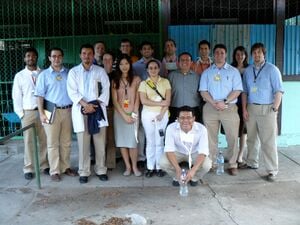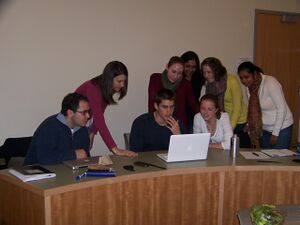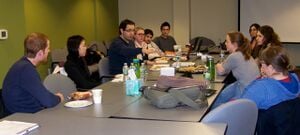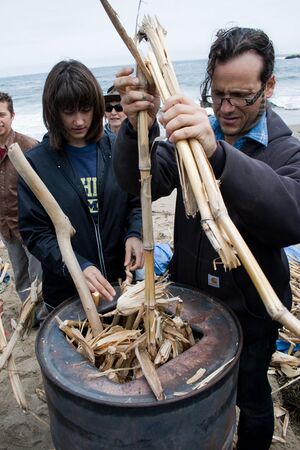

The Global Health Medical Device Compendium is an inventory of medical devices designed for use and/or implemented within resource-limited settings. The compendium is sortable by health topic (e.g., Malaria and HIV/AIDS), classification (i.e., Preventative, Diagnosis or Treatment), scope (i.e., Prototype, Clinical trial, Commercialized) and location (by continent).
The Global Health Medical Device Compendium is the work of Prof. Kathleen Sienko and her graduate students, and the Center for Global Health Student Associates at the University of Michigan. See Portal:Medical Devices for the result of the partnership with Appropedia or browse all devices.
Acknowledgments




For their collaboration we thank Prof. Kathleen Sienko, who directed student research on a global health compendium through her Design for Global Health course and represented the Center for Global Health at the University of Michigan, Center for Global Health Director Dr. Sofia Merajver, Linkages and Education Officer Kate Restrick, Technical Support Manager Uma Karri, and Student Associate Amir Sabet Sarvestani. This work was partially supported by the University of Michigan Center for Global Health Junior Faculty Engagement Award and previously presented at the WHO's First Global Forum on Medical Devices (Bangkok, 2010) and at the Design of Medical Devices Conference (Minneapolis, 2011).
Prof. Sienko's ME/BME/ENGR 599 Design for Global Health: Sustainable Technologies for the Developing World
The design and development of health-related technologies for resource-limited settings requires a detailed consideration of the end user and target community that goes beyond the traditional engineering design needs assessment. In a broader sense, economic, social, and cultural constraints must be considered for successful implementation of technologies. This course emphasizes a multidisciplinary approach to global health design and interactions between engineering disciplines and nontechnical fields via lectures, case studies, group discussions, an optional experiential field site experience, and the development of a medical device and healthcare technology compendium. Students explore the current state of global health challenges and assess best and worst practices regarding technology design principles that address those problems. Students travel to Nicaragua during Winter Break to conduct clinical observations in rural and urban health clinics.
ME/BME/ENGR 599 Student Contributors (Winter 2010)
Dayna Anderson, Doug Andersen, Tejkaran Gill, Brian Holcomb, Chang Jiang, Rajen Kumar, Chris Maue, Kelley Maynard, Joseph Perosky, Amir Sabet Sarvestani, Ally Schafer, Kim Song, Mike Weist, Danielle Williams, Mike Yee.
The University of Michigan Center For Global Health
The University of Michigan has a legacy of working on critical health issues through research and action. The Center for Global Health builds on this tradition by generating novel approaches and partnerships that improve health and redress pressing health inequalities. Through its research, training, and service activities the Center is centrally concerned with work that aims to promote global health equity. The University of Michigan is replete with students at all levels who are, or hope to be, engaged in global health activities as part of their education and of their careers. The Center for Global Health brings together the strength and expertise of University of Michigan faculty and students to find and implement sustainable solutions that improve health by solving specific problems with partners around the world. Through a Student Associate program, the Center for Global health helps students at all levels from across the University to become engaged and create a vibrant, intellectual community interested in producing scholarship and tangible progress in global health equity.
2010-2011 Center for Global Health Student Associates and Contributors
Kelley Maynard, Anthony McCoy, Michael McHenry, Sofia Meissner, Joseph Perosky, Rebecca Schewe-Mott, Lee Schrauben, Manan Shah, Nijika Shirvastwa, Roy Smoot, Lindsay Townes, Caitlin Winget, Amir Sabet Sarvestani (project leader).
2011-2012 Center for Global Health Student Associates and Contributors
Aekka Apoorva, Sepideh Ashrafzadeh, Eva Shiu (team leader), Ryan Frisbie, Jillian Plonsker, Sandhya Kajeepeta, Michael McHenry, Rajen Kumar, Chris Maue, Ibrahim Mohedas (team leader), Bryan Ranger, Linda Schultz, Lindsay Townes (team leader), Caitlin Winget, Amir Sabet Sarvestani (project leader).
2012-2014 Student volunteers - University of Michigan
Aekka Apoorva, Jay Antonishen, Elizabeth Hyde, Jillian Plonsker, Lindsay Townes (team leader), Eva Shiu, Caroline Soyars (team leader), Kelly Wojcik, and Amir Sabet Sarvestani (project leader).
University of Michigan and Appropedia
Appropedia Founder and Humboldt State University Lecturer Lonny Grafman met University of Michigan Assistant Professor Kathleen Sienko at the 2009 NCIIA-sponsored Indian Point International Development and Appropriate Technology conference. During the meeting the two discussed possible collaborations on the topics of engineering education, service learning, and appropriate technologies. Lonny, Kathleen, and the Center for Global Health teamed up in the summer of 2011 to initiate the collaboration.
Viewing the medical device compendium
- Browse data: Medical Devices - drill down into the device database.
External links
- Global health: Students build wiki of medical devices designed for low-income countries, Nicole Casal Moore, University of Michigan, (Apr. 19, 2012).
- UMich Medical Device Wiki Lets Low-Income Nations Know What Technologies Are Out There, Scott Jung, Medgadget, (Apr 26, 2012).
- Global Journal of Engineering Education - Medical device compendium for the developing world: a new approach in project and service-based learning for engineering graduate students
- Open-Source, Wiki-Based Medical Device Compendium for Global Health - Poster at World Health Organization